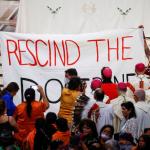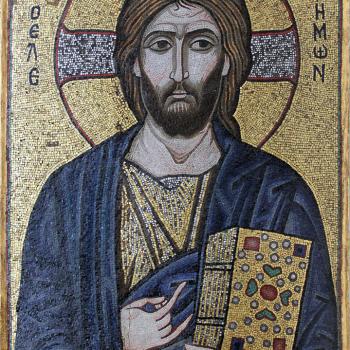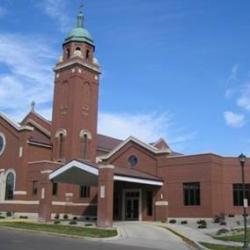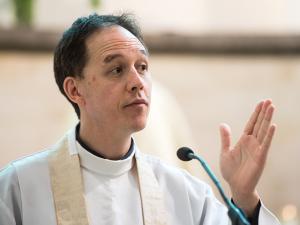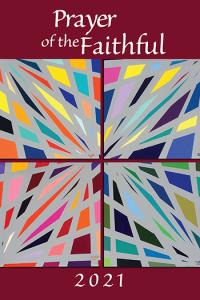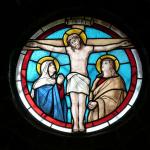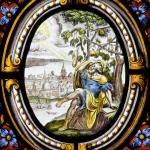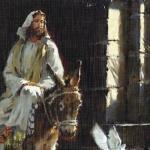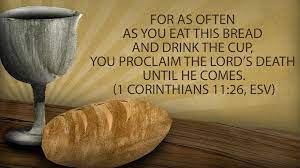
My parish makes a big deal out of what to call the two forms under which we receive Communion. When the bread and wine have been consecrated, can we still call them bread and wine? The consensus among parish leaders and teachers is that we cannot. Transubstantiation means that the bread is no longer bread, and the wine is no longer wine. In my parish we can say “form of bread” and “form of wine.” Without that technical language, we are told to say “body” for what was bread and “blood” for what was wine. But the Liturgy itself says, “When we eat this bread and drink the cup, we proclaim the death of the Lord until he comes.”
What gives? How can the Liturgy say the consecrated host is bread when the Church says it is no longer bread? On other hand, why can’t we use the words that the Liturgy does?
Then again, how is it right to call the host “body” and the contents of the cup “blood” when we know the whole Jesus is present under both forms?
The Bible helps.
The American Church started a three-year Eucharistic Revival after receiving a theological scare. Polls revealed that perhaps a majority of Catholics no longer believe in the real presence of Christ in the Eucharist. There was bound to be some over-reacting, and my parish’s fixation on names may be a case of it. What do Jesus and the Bible say about names?
Jesus calls himself bread. He is the “Bread of Life.” (John 6:35 and 48) In the same context we hear “true bread of heaven” and, “The bread of God is that which (or he who) comes down from heaven and gives life to the world.” (John 6:32-33) And Jesus, or the Gospel writer, surely meant Eucharist because a little later we read:
I am the living bread that came down from heaven. Whoever eats of this bread will live forever. And the bread that I will give for the life of the world is my flesh. (6:51)
Then there’s the earlier theologian Paul:
The bread that we break, is it not a sharing in the body of Christ? (1 Corinthians 10:16)
And,
Because there is one bread, we who are many are one body, for we all partake of the one bread.” (10:17
Jesus does not refer to himself as wine. We have no biblical warrant for calling the contents of the cup wine. But,
“The cup of blessing that we bless, is it not a participation in the blood of Christ? The bread that we break, is it not a participation in the body of Christ…. You cannot drink the cup of the Lord and the cup of demons. You cannot partake of the table of the Lord and the table of demons.” (10:16, 21)
And,
“This cup is the new covenant in my blood.” (11:25)
“Eat the bread” and “drink the cup” – naming the elements biblically
We say “host” for the consecrated Eucharistic bread. “Host” comes from the Latin hostia, meaning sacrifice. That’s a valuable connection lost to most English speakers. Missing, though, is another Eucharistic connection. Jesus clearly intended the Eucharist to be not only sacrifice but also meal. For the latter we have the word “bread.” It’s legitimate because Jesus is “bread from heaven.” That sounds like a metaphor. But Jesus also calls his Eucharistic self “bread,” sounding very literal.
“Cup” is a figure of speech, a synecdoche, to get technical. The cup stands for itself and what it contains, and that’s a lot:
As often as you eat this bread and drink the cup, you proclaim the death of the Lord until he comes. Therefore whoever eats the bread or drinks the cup of the Lord unworthily will have to answer for the body and blood of the Lord. A person should examine himself, and so eat the bread and drink the cup” (1 Corinthians 11:26-28)
“Cup” may be the best way to refer to Christ present under the form of wine. It does double duty, representing—making present—both meal and sacrifice. To drink the cup is to participate in a meal, and the resemblance to blood brings Jesus’ sacrifice to the center of attention. Jesus made drinking the cup “that I shall drink” a symbol of supreme sacrifice. (Matthew 20:23)
“Bread” also can do double duty. It’s food of course. But think about the first time Jesus offered himself as bread – at the Last Supper. To Jews celebrating the Passover, that bread was the “bread of affliction,” the affliction of Hebrew slaves. (See this post.) Jesus must have united his own coming affliction with theirs as he called the bread his body “given for you.” (Luke 22:19)
The body and the blood
Eucharistic ministers say to the communicants, “The Body of Christ.” And again, “The Blood of Christ.” It may seem as if we’re receiving one part of Jesus and then another, rather than the whole in each form.
But those liturgical words are not sentences. It’s not like: “this is the body” and “that is the blood.” The ministers’ words are noun phrases. They name something for us to respond to without telling us what to think, as a sentence could. Surely that’s a deliberate choice by those who gave us this liturgical text, and – I’d say – a good one. As nouns, not sentences, they don’t give us doctrine: This is Jesus. They don’t limit Jesus, or his body or his blood, that way. They let us participate in the mystery of everything body and blood can be for us.
The body is the thing about a person we can touch. In this case “Body” can mean Jesus present as the bread that we touch and consume. But it can also be the whole body of believers coming forward to touch and consume. It can mean the body of Christ throughout the world, whose members all touch Jesus’ body and are touched by others, stretching back in time in a line of sacred touches, to the ones who touched and were touched by the One from Nazareth.
Blood makes us think of life. A life freely given with the outpouring of blood, but also life received. This life enlivens the members of the body of Christ and reaches from these to the world all around.
The cup or the chalice?
The conclusion of these thoughts is that, when speaking of the consecrated Eucharistic elements, it is proper – and probably best – to say “bread” and “cup.” One can surely expand with phrases like “bread of heaven” and “cup of salvation” or “cup of blessing.” One might wonder, Why not “chalice,” since that is the word the new translation of the Liturgy uses?
Having praised one choice by the authors of our liturgical text three paragraphs ago, I now offer a critique. “Chalice” seems simply wrong to me. With this word one thinks too much of the vessel. “Drink the cup” sends the mind immediately to the contents of the cup. It sounds perfectly natural. “Drink the chalice” sounds as if I’m more concerned than I need to be that the vessel be appropriate to the mystery it contains. I don’t know if the cup Jesus used at the Last Supper was fancy enough to be a chalice or if it was just a cup; and I don’t think it matters.
In Latin class I learned that “calix” means cup. In English Bible translations, including the one we use for the Gospels, “calix” is always “cup.” And previous translations of the Eucharistic Prayer also gave us “cup.” The change to “chalice” seems to me to be a pointless attempt to add reverence to what always felt as awesome as anything could be.
The cup from which we drink at the altar should be beautiful, as far as the financial means of the celebrating community permit. That way it gives reverence to the mystery it holds. But it offers that reverence without our puttng a name on it, just by being what it is.
Image credit: Phil Ressier


